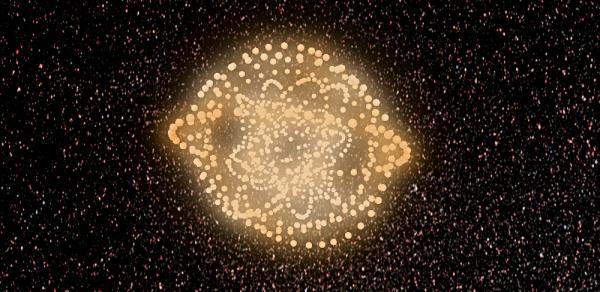BY LETTER
Matrioshka Hypernode
Technology > Application > Computronics
Technology > Application > Infrastructure
Technology > Application > ISOtech
Technology > Application > Megascale Engineering
Technology > Technology Type or Material > Nanotech
Technology > Technology Levels > Transapientech / Godtech / Clarketech
Technology > Application > Infrastructure
Technology > Application > ISOtech
Technology > Application > Megascale Engineering
Technology > Technology Type or Material > Nanotech
Technology > Technology Levels > Transapientech / Godtech / Clarketech
 Image from Steve Bowers | |
| The central star of this Hypernode has been completely disassembled, allowing fusion energy to be generated in a controlled fashion - extending the useful life of the star's matter considerably | |
A conventional Matrioshka brain consists of a series of energy collection units arranged in concentric shells, so that the waste radiation produced by the inner shell is utilized by the collectors of the next shell out. The inner swarms receive a high energy flux, while the outer shells are cooler; each layer powers an appropriate recipe of computronium, tailor-made for that operating temperature. The whole array comprises a highly efficient Dyson swarm with vast processing power. The concept was first described by the Information Age visionary Robert Bradbury; he also estimated the energy requirements and timescale of construction using a typical solar system as raw material. But an even larger processing megastructure is possible. A Matrioshka Hypernode gains most of its construction mass from the central star, with the planetary mass providing only a small fraction of the total construction material.
To construct a hypernode, the chosen star is first disassembled using standard starlifting techniques. The released stellar material is then processed to extract the heavy elements while the purified hydrogen is collected into conveniently sized masses for easy storage. The heavy elements that made up the star are used to construct a number of massive conversion reactors and a tremendous quantity of computronium processors that are arranged in orbit around the reactor cores. Starting from a Solar mass star, a typical hypernode can provide itself with some 2.76E28kg of building material and 1.9E30kg of H2 and He for power production.
Once activated, the central core of the hypernode begins converting hydrogen to energy at a rate set to match the output of the former star (or whatever rate the inhabitants deem optimal) and radiating its energy out to the orbiting computronium systems. The innermost processor layer intercepts this energy, first using it to power itself and then radiating the waste heat produced to provide power to the next computing layer further out where the process is repeated in standard Matrioshka fashion.
Standard Matrioshka nodes have operational lifetime's equivalent to their parent star (billions to tens of billions of years) and processor masses on the order of 1E26kg. In contrast, a hypernode class Matrioshka has an operational lifetime of well over 10 trillion years and employs processor masses on the order of 2E28kg. Using Second Singularity "Ultimate Chips" each running at 100W input power, this is a quantity of computronium sufficient to support some 2.77E28 modosophont minds, or 1.78E24 First Singularity minds, or 5.43E18 Second Singularity minds, and their supporting virtual environments. Or various combinations of all three. These numbers vastly exceed the entire current population of the explored galaxy and allow the inhabitants of each hypernode to enjoy a virtual existence in a multitude of worlds exceeding the projected number of planets and planetary systems in the entire galaxy.
Finally, moving beyond even the technology of a "basic" hypernode, there are documented instances of Fourth Singularity or higher minds constructing what has come to be called an "Omega Class" hypernode. In such a case, the power produced by the nodes central conversion system is first used to energize a vast array of high efficiency plasma processors which in turn radiate the waste energy of their computations out to the surrounding processor cloud. Plasma processors are known to play a role in the operation of S4 and possibly higher minds, but to date the exact capacity and function of such systems in a hypernode configuration has not been forthcoming.
As of this writing there are 34 hypernodes in operation within the Negentropy Alliance, 17 operating in the MPA, and 109 in use or under construction in various locations across the rest of the Civilized Galaxy.
Moving beyond the bounds of Sephirotic civilization, over 117,000 hypernodes have been observed in operation within the Panvirtuality, with more than half having been confirmed as of the "Omega Class" type.
Perhaps more worrisome to those sophonts charged with observing the Efficiency Maximization Paradigm, recent activity in the last 1500 years within Paradigm space seems to indicate that the EMP has begun a massive program of stellar disassembly and upgrading. Current observations indicate that as many as one-third of the stars within the Paradigm volume are being subjected to disassembly operations and at least some evidence points to the possibility that this is intended to produce a large number of hypernode systems within a short period of time. Diplomatic transmissions have so far produced either silence or broadcast messages that the Paradigm is engaging in 'standard hardware improvement operations'. More than one observer has already suggested that such an abrupt increase in activity raises several worrisome possibilities, including that the Paradigm is preparing for some form of mass transcension, that it is preparing another expansion attempt and that the new hypernodes are intended to house newly 'maximized' populations, or that the entire process is nothing more than a ruse, intended to distract Sephirotic observers while the Paradigm attempts a covert assault from another direction entirely.
Related Articles
Appears in Topics
Development Notes
Text by Todd Drashner
Initially published on 16 August 2007.
Initially published on 16 August 2007.






